This website uses cookies so that we can provide you with the best user experience possible. Cookie information is stored in your browser and performs functions such as recognising you when you return to our website and helping our team to understand which sections of the website you find most interesting and useful.
Bordeaux 2021 tasting notes: Margaux
Bordeaux correspondent Colin Hay gives his verdict on the wines of Margaux, which he says typifies the new classicism of the 2021 vintage, accentuating the return to the elegance, finesse and precision that are the appellations watchwords.
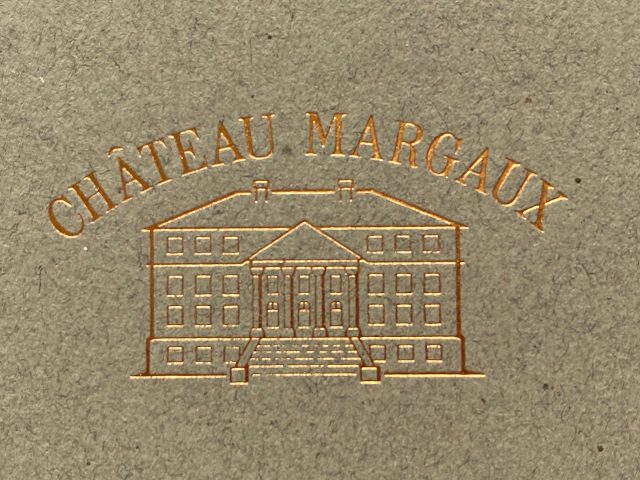
Before I embark on my tasting notes for each chateau, a note on the ratings.
This year, for the first time, I have decided to provide an indicative rating for each wine alongside the published comment. All such comments and ratings are necessarily subjective (they cannot be anything else, when one thinks about it). I would urge you to look at the two together and, if anything, to privilege the comment over the rating. My aim is more to describe the wine in the context of the vintage, the appellation and recent vintages of the same and similar wines, rather than to judge the wine per se.
The ratings, of course, reflect my subjective relative preferences between wines. Your palate is likely differ from mine. I hope that my comments give you at least enough information to be able to recalibrate my ratings and, in so doing, to align them more closely to your palate. To give an example: if the idea of the ‘new classicism’ leaves you cold, you may well wish to discount the (typically high) ratings I have given to wines described in such terms.
2021 is, of course, a highly heterogenous vintage – and, consequently, my ratings span a considerable range (from the very high to the very low). I see little interest, either for the consumer or the producer, in publishing very low scores. Consequently, I have decided not to publish scores for wines that I have rated below 90 (here the range 89-91). Where no rating is published, the wine would have scored 88-90 or below.
Finally, élevage is likely to be very important in determining the quality in bottle of these wines (rather more so than in recent vintages). I am no soothsayer and cannot predict how that will turn out. All en primeur ratings should be treated with caution and taken with a certain pinch of salt. That is never more true than it is in this vintage.
Full tasting notes & ratings
- Alter Ego de Palmer (Margaux; 60% Cabernet Sauvignon; 32% Merlot; 8% Petit Verdot; a final yield of just 22 hl/ha; chaptalised to 13% from around 12.5% natural alcohol; sulphur free alcoholic fermentation; 1st year in barrel; 2nd in 30 hectolitre foudre to accentuate the terroir expression; tasted at the property). There was quite significant frost and mildew damage here, especially to the (predominantly Merlot) plots further from the river. This is very intensely floral on the nose. Beeswax, cedar and graphite too. One the palate, there is a lovely natural sweet ripeness to the fruit that is unusual in the context of the vintage. Crushed, bright and energetic red and black berry fruit that is very crunchy with an impressively whole-berry feel to it. A little chocolate and liquorice too and a hint of exotic Asiatic spice. There is nice body and substance to this and it feels like ‘proper claret’, even if this is a little less fluid and dynamic through the mid-palate as a consequence. 91-93.
- Angludet (Margaux; 53% Cabernet Sauvigon; 23% Merlot; 22% Petit Verdot; just 12% alcohol; a final yield of 26 hl/ha; aging in a combination of oak barrels, 50% of which are new, and amphora; tasted at the UGCB press tasting). Very much of its appellation, this is more hedgerow and herbal than floral per se, but is expresses very well its terroir typicity. A little touch of chocolate; pure cherry and berry fruit; quite crunchy too. Tender, tense, fresh and yet soft and nicely formed. Not massive, but very Margellais. 90-92.
- L’Aurore de Dauzac (Margaux; 62% Cabernet Sauvignon; 37% Merlot; 1% Petit Verdot; from a distinct fine and sandy gravel terroir; tasted at the property). This is much more floral than Labastide with violets and lavender and the wild spring flowers one finds again in the grand vin; dried and even candied rose petals too. Cassis and a crisper, brighter fruit than its sibling. Cooler, deeper, richer and with a finer silkier tannin too, this is also more lithe and racy. It works really well in the vintage conditions and showcases the quality Cabernet fruit. Very Margellais. A lot of grip on the finish. No dryness. 90-92+.
- Baron de Brane (Margaux; 50% Merlot; 46% Cabernet Sauvignon; 3% Cabernet Franc; 1% Petit Verdot; 12.9% alcohol; pH 3.63; with an impressive yield of 41.2 hl/ha; tasted at the property). Nice and tender; beautifully lifted; fresh; dark fruit-scented with a wild aromatic herbal element too. Cassis and redcurrant, a little cranberry too. We sense the freshness of the fruit rather than acidity of the wine (which isn’t always the case in this vintage). Crunchy fruit and lovely svelte tannins, this is supple, plump and pulpy but lithe and gentle at the same time with a finely detailed mid-palate. The gentle extraction here, using the R’Pulse system really pays dividends in this vintage. An excellent an authentic second wine. 90-92+.
- Blason d’Issan (Margaux; 52% Merlot; 46% Cabernet Sauvignon; 2% Petit Verdot; 13.1% alcohol; aging in oak barrels, 35% of which are new; pH 3.57; IPT 63; tasted at the property). Elegant with dark briary fruit notes rapidly accompanied by cedar as the wine starts to breath in the glass. Plump and pulpy, with a pure redcurrant and blackcurrant fruit. Lightly textured, but rather lovely. Classy and with a distinct signature of Issan. Very Margaux, if perhaps more in its herbality than its florality. A very successful second wine in a challenging vintage. 90-92.
- Brane Cantenac (Margaux; 74% Cabernet Sauvignon; 22% Merlot; 2% Cabernet Franc; 1% Malbec; 1% Petit Verdot; 12.7% alcohol; a final yield of 41.2 hl/ha; pH 3.66; tasted at the property). Archetypally Brane, with its redolent cassis and cedar notes. In comparison with the 2019 and 2020, it is somewhat less explosively floral with the wild herbal elements showing first. Walnut shell and walnut oil too. This is very classic in a slightly tender and cool vintage way. It is, as ever, sublimely textured, all the more so for being fuller, richer and more ample than most. But, crucially, that additional volume comes with no loss in the luminous, lithe and dynamic character of the mid-palate. This is very pure with a dark ripe berry fruit. Stylish, cool, elegant and long with an impressive evolution over the palate, the amplitude gradually descending to a slowly tapering finish through a succession of waves – with sapidity locked into each. Very refreshing and with a lovely sense of balance and harmony. The quality of the satin-textured tannins (the product of the gentle extraction afforded by their much-coveted R’Pulse system) is extraordinary. 93-95+.
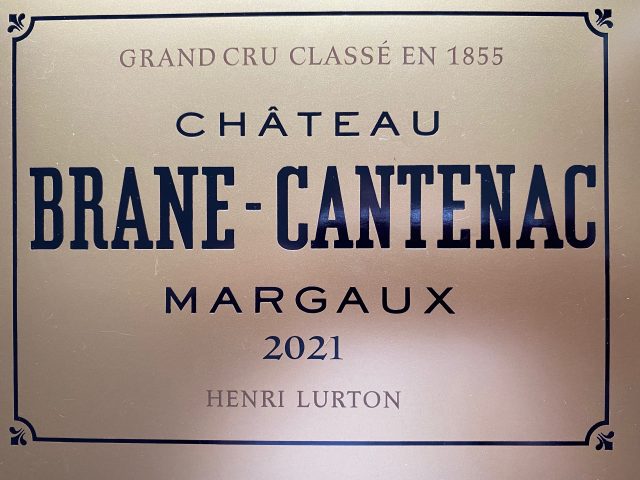
- Cantenac Brown (Margaux; 73% Cabernet Sauvignon; 27% Merlot; aging in oak barrels, 60% of which are new; tasted at the UGCB press tasting). Very classy and elegant on the nose, with a seductive gentle suggestion of oak influence – vanilla and sweet spice, but all very restrained. Graphite, walnut skin and a delightful hint of the cedar to come. Deep rich berry fruit, with pleasing floral elements (more than I recall in recent vintages) – lily and peony. Pure, precise, fresh and focussed with good if not massive concentration and lovely balance and harmony. Excellent wine-making is on display here with a series of pitch perfect choices that reinforce the identity and terroir typicity of this exciting wine. 93-95.
- Dauzac (Margaux; 70% Cabernet Sauvignon; 30% Merlot; 13% alcohol; a final yield of 44 hl/ha; aged predominantly in oak barrels, 65% of which are new, with a small proportion in amphora; tasted at the property and the UGCB press tasting). Complex and enticing on the nose, with plenty of Margaux florality – wisteria, violets and lavender – combined with a distinct saline-ferrous minerality and a rich, deep, dark berry and stone fruit. The palate is limpid and lithe with delicate layering that is not obscured thanks to the judicious restraint in the extraction. There is an impressive natural ripe sweetness to the fruit and a gentle smokiness too. Nicely composed and very promising. 91-93.
- Dauzac Franc de Pied (Margaux; 100% un-grafted young vine Cabernet Sauvignon on a fine gravel and sand terroir; just 0.52 hectares; 12.5% alcohol with no chaptalisation; aged in (4) amphorae; tasted at the property). It is exciting to taste for the first time this fascinating and, as yet, unique project. On the nose, this is extremely pure and almost viscerally floral – it’s like walking through a wild alpine pasture in spring; the fruit is bright and fresh – cassis and red cherries. There are interesting nutty notes too – sesame seeds, new season almonds and even fennel seeds. On the palate, the fruit is brighter still and a shade lighter – fleshy raspberries and the sense of chewing on their (ripe) pips; blood orange too. Overall, it’s almost like a more Cabernet Franc expression of Cabernet Sauvignon (with more acidity and more of a natural herbal element). The texture, too, is very fine and satinous with a lovely gentle grip from the crumbly tannins. An exciting introduction to this wine. 93-95.
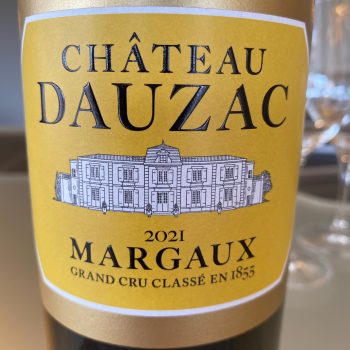
- Desmirail (Margaux; 45% Cabernet Sauvignon; 45% Merlot; 5% Petit Verdot; 5% Cabernet Franc; 12.7% alcohol; 41 hl/ha; tasted at the UGCB press tasting). This seems very ambitious and perhaps a little forced. It is one of the more oaky samples, but there are nice cedar elements and a rich, dark, bright and lifted fruit too. On the palate this is just a little sweet and even slightly confected. It’s creamily textured but lacks detail and finesse. There is some tension but the tannins, though soft to start with, are a little raw on the finish. This lacks harmony at least at this early stage. A bit of a shame.
- Deyrem Valentin (Margaux; cru bourgeois supérieur). This is interesting and rather impressive. On the nose this is dark, earthy and rich, unusually so in the context of the vintage. The fruit is a combination of bright cassis and pulpy brambles and blackberries and with more air there’s a little hint of hedgerow flowers that strongly hint at Margaux typicity. On the palate this is full, rich, deep and compact, with a well-defined core and svelte tannins. The finish is a little abrupt, but overall this has been nicely judged. 89-91.
- Durfort-Vivens (Margaux; 97% Cabernet Sauvignon; 3% Merlot; aging for 18 months, 70% in new oak, 30% in amphora; tasted at the property). Cool, deep, austere and beautiful – with a very natural, elegant plunge-pool purity. Sesame seeds, very dark pure and crystalline berry fruit with damsons and sloes too, cassis and concentrated raspberry coulis; a suggestion of walnut oil too – rare in this vintage. There is a hint of the cedar to come, but this is much more about the fresh pulpy fruit for now. Violets, preserved violets and the parfumier’s essence of violet; hyacinth and peony too. Wild, herbal and slight gamey elements appear with greater aeration. This is texturally sublime on the entry with a lovely core of black cherry and damson fruit, ultra-refined tannins and great presence, compact density and purity. This is a wine with great concentration, depth and delineation – a combination that is very rare and very difficult to achieve in this vintage. An exceptional wine, with something of the calm tranquillity and refined grace and elegance of Pichon Comtesse de Lalande in recent vintages. One of the stars of the appellation and, indeed of the entire Médoc. 95-97.
- Ferrière (Margaux; 81% Cabernet Sauvignon; 13% Merlot; 5% Petit Verdot; 1% Cabernet Franc; tasted at Durfot-Vivens). Cool, refined and pure, with a nice touch of graphite and a lovely minerality alongside the bright and brilliant fruit – cassis, redcurrant, cranberry, but also raspberry purée and mulberry. Super-soft on the entry, and with the racy acidity brilliantly incorporated and distributed across the palate, this builds to a lovely and intensely sapid crescendo. The Cabernet Sauvignon is the star here and that gives a superb fresh cassis signature to the fantail finish. Likely to be excellent value. 92-94.
- Giscours (Margaux; 60% Cabernet Sauvignon; 32% Merlot; 5% Cabernet Franc; 3% Petit Verdot; a final yield of 38 hl/ha; 13.5% alcohol; tasted at the UGCB press tasting). Intense plum, damson and black cherry fruit with a little grated dark chocolate, a nice hint of graphite too and a very enticing Margaux florality. Big, bold, rich and deep, very darkly fruited and impressively compact, dense and concentrated for the vintage. Super-svelte on the attack, with ultra-soft fine-grained and grippy tannins and great length. The tannins support the fruit well and the acidity is very well incorporated. This is compact and yet broad-shouldered, multi-layered and finely detailed. Impressive wine-making and a continuation of the significant progress made here since 2018. 93-95.
- La Gurgue (Margaux; 54% Cabernet Sauvignon; 27% Merlot; 19% Petit Verdot; tasted at Durfort-Vivens). Distinctive, with great brightness and a very natural sense of clarity on the nose. Fresh, aerial, and lifted with an expressively pure and crunchy cassis, redcurrant and freshly hulled raspberry fruit profile. Soft and gentle on the attack, with good concentration, nice grippy tannins and a sapid transition to a long and chewy, bright and crunchy fruit-filled finish. The mid-palate is just a little lacking in delineation, but this is very good. 90-92.
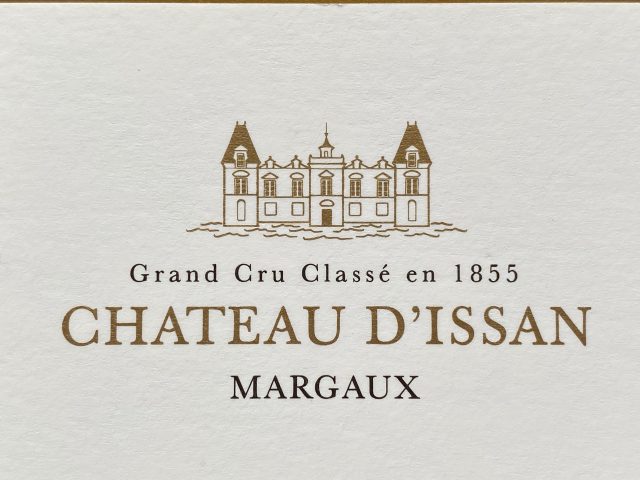
- D’Issan (Margaux; 65% Cabernet Sauvignon; 30% Merlot; 2% Cabernet Franc; 2% Malbec; 1% Petit Verdot; aging in oak barrels, 50% of which are new; 13.2% alcohol; pH 3.60; IPT 66; tasted at the property; Eric Boissenot is the consultant here). This is a little firm and closed on the nose at first. But once it relaxes and starts to open, it is gracious, cool, calm and rather lovely. This is archetypally of its terroir and its appellation and it has the cool vintage signature of the vintage too. Stylistically, it is now the closest wine in the appellation to Margaux itself. There is loads of graphite here; freshly picked wild herbs and a beautiful and very natural florality. On the palate, this is clear and crystalline; it glistens as it glides in and through the detailed mid-palate where, again, we find lots of lovely Margaux typicity. This is very pure, with intense crunchy fresh bright and lifted dark berry fruit – blackcurrant, blackberry and redcurrant leaf, a hint of blueberry and mulberry too. There is a delicacy and finesse to the fine-grained tannins and this builds nicely through the mid-palate to a very lifted and stylish, elegant and refined finish. Some might find this a little slender. But what it lacks in weight and density it more than makes up for in grace, elegance and precision. Above all, for me, this wine is characterised by it eloquent evolution over the palate. A great success and another clear marker of the great progress made here over the last few vintages. 93-95+.
- Kirwan (Margaux; 73% Cabernet Sauvignon; 13% Merlot; 8% Cabernet Franc; 6% Petit Verdot; 13% alcohol; tasted at the UGCB press tasting; Eric Boissenot is the consultant here). Beautiful in the glass, with a very radiant lilac rim. This is pure and lifted and very true to its recent style. It is ultra-fresh but there is no harsh edge to the acidity. Instead, there is great lift and precision to the bright, crunchy cassis, redcurrant and briary bramble fruit. Another Margaux wine in this vintage that is pure and compact, the fruit clinging tightly to the spine. Some will no doubt find this a little slender but I rather like that (and I suspect it’ll put on further flesh during élevage). Laser-sharp in its precision, this is impressively pure and linear. It is so very different to how it used to be, with no hint of the oak. I am a fan. 92-94.
- Labastide Dauzac (Margaux; 54% Cabernet Sauvignon; 45% Merlot; 1% Petit Verdot; aging in a combination of barriques and foudres this comes from a distinct clay-gravel terroir that is particularly propitious for the Merlot; tasted at the property). Here we find, in a concentrated form, the salinity and iron minerality of Dauzac. Nice dark berry and stone fruits with a pleasing dollop of cassis too alongside the assorted wild herbal elements. This is nicely constructed and very expressive of its terroir. There is also a satisfying sweetness to the fruit. 89-91.
- Labégorce (Margaux; tasted at the UGCB press tasting). Nutty and quite oaky for the vintage, but with a nice intensity to the dark bramble and black berry fruit. There’s a pleasing twist of cracked black pepper too and a hint of the crackle and smoke of the bonfire. Attractive, distinctive and very true to its style with a nice pleasing natural sweetness to the fruit. Open-textured, with good balance if not especially concentrated or dense. Sapid and lifted on the finish. Some good choices have been made here. 89-91.
- Lascombes (Margaux; 50% Merlot; 45% Cabernet Sauvignon; 5% Petit Verdot; a final yield of 41 hl/ha; 13.5% alcohol; aging for around 18 months in oak, 60% of which is new; tasted at the UGCB press tasting). Ah, yes, Lascombes – it is immediately very familiar. One tunes in first to that signature wisteria and mimosa floral element, dried rose petals and parfumier’s violets too. Then we have the complex and, again, rather distinct fruit profile – black and sour cherries, brambles and mulberries, with a hint of grated dark chocolate (here more a spice that a source of sweetness) and liquorice root (similarly). This is cool and soft on the entry, with very refined tannins, the new wine-making facility seemingly taking this to a new level in terms of finesse. Lovely black cracked peppercorns and Asiatic spices bring further interest and detail. Overall, this is very balanced, harmonious and refined. The oak is less prevalent and the chewy grape-skin finish is long and gracious. 92-94+.
- Malescot Saint-Exupéry (Margaux; 50% Cabernet Sauvignon; 35% Merlot; 10% Cabernet Franc; 5% Petit Verdot; 13% alcohol; a final yield of 40 hl/ha; tasted at the UGCB press tasting). Pure, precise, bright and focussed with a lovely cedary signature on the nose and a pleasing graphite and crushed stone minerality too. Mulberries and fruits of the forest; wild thyme too. Similar in style and texture to Lascombes with sweet exotic spices, a touch of grated dark chocolate, roasted coffee bean, wood-smoke and a hint of root liquorice. This is very stylish and refined, as ever, but I find the tannins just a shade dry and the mid-palate lacking just a little delineation. I prefer the trio of 2018-2020 here; time will tell. 91-93+.
- Margaux (Margaux; 87% Cabernet Sauvignon; 8% Merlot: 3% Cabernet Franc; 2% Petit Verdot; 13.1% alcohol; pH 3.65; IPT 75 (the same as 2019); tasted at the property). There was significant frost damage in the vineyard here, but mainly on inland parcels destined for the 3rd and 4th wines. By contrast, mildew pressure was largely controlled without any significant loss, the grapes ultimately harvested in excellent sanitary condition. A glorious and gracious Chateau Margaux that is beautifully refined and elegant with an exquisite pure dark cool-summer berry fruit profile of brambles, black cherries and cassis. The texture on the attack is breathtakingly soft, with the wine exhibiting a very natural calm tranquillity and a measured calm confident authority. Though the structure is quite tight, the fruit strapped close to the spine, it is dense and compact; the effect is that tannins, so often silky at their best in this relatively light vintage, are more velvety in texture reflecting the sheer depth and concentration of the fruit. This is one of the few wines of the vintage to have a pronounced core around which the structure of the wine is built. The role played by the press wines (here around 10-12%) was crucial. In the mid-palate this glides, glistens, shines and shimmers with clarity and a luminous and aerial, almost radiant, quality. And, right at the end, the cassis fruit is eventually released from the bind of the tannins and it builds and grows fabulously to a sapid and refreshing fantail crescendo on the finish. Very moderated, very classy, very precise and very special indeed. 96-98.
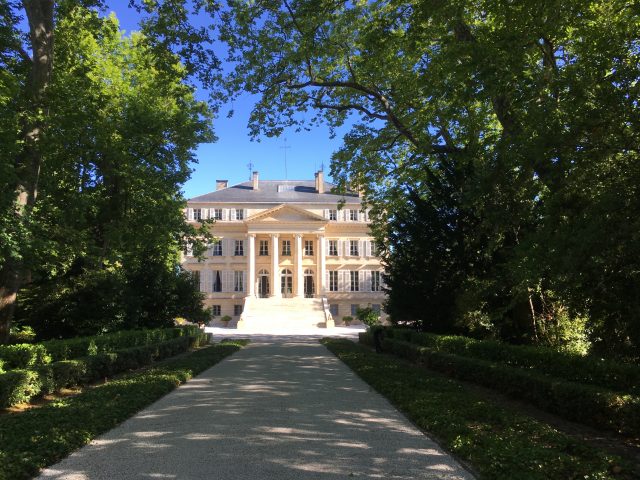
- Marquis d’Alesme. Not yet tasted – tasting note to be added later.
- Marquis de Terme (Margaux; 60% Cabernet Sauvignon; 35% Merlot; 5% Petit Verdot; 13% alcohol; a final yield of 40 hl/ha; tasted at the UGCB press tasting). This is easy, accessible and engaging. Dark, rich chocolate and black cherry fruit – a bit of the black forest here. This is seductive on the nose. And on the palate too, with very fine-grained cashmere tannins which wax and wane in little ripples of fruit through the quite dense mid-palate. Impressively compact and concentrated too, with a rolling, rippling sapid finish, if not perhaps quite the complexity, detail or delineation of the truly great. 91-93.
- Monbrison (Margaux; 70% Cabernet Sauvignon; 20% Merlot; 7% Cabernet Franc; 3% Petit Verdot; 13% alcohol; a final yield of 38 hl/ha; tasted at the UGCB press tasting). This has lovely Margaux typicity and significantly exceeds my expectations. Intensely floral and reminiscent of a bunch of spring flowers freshly picked from the wild pasture and hedgerow; there’s a lovely cedar element too; and that very dark crunchy briary berry fruit. Overall, there is a superb natural freshness to this and I am no less impressed by the very refined precise and granular tannins. The attack is bright, there is a palpable sense of energy through the mid-palate and the finish – all chewy grape-skins – is natural and composed. Remarkably good. Un coup de coeur. 91-93+.
- Palmer (Margaux; 56% Merlot, 41%Cabernet Sauvignon, 3% Petit Verdot; aging in oak barrels, 70% of which are new; a final yield of just 22hl/ha; 13.5% alcohol; tasted at the property). A very exciting wine and a rare exception to the left-bank rule in this vintage that the more Merlot in the blend the more difficult the wine is. For what makes this great is the Merlot. As with Alter Ego, this starts promisingly with a pleasing natural ripe sweetness on the nose that is reflected on the plate. The intensity of the dense yet vibrant fruit is fabulously impressive. Wow! A kaleidoscope of colour. Black, purple and lots of vivid red berry fruit – raspberry and loganberry purée – plump mulberries and brambles too. This has impressive volume for the vintage and quite a bold structure. Yet the frame is amply and in fact densely covered and there is no dip in the fruit intensity. There is also a lovely salinity and creaminess to the mid-palate. But what is perhaps most exciting about this wine is the way in which the sapidity and the salinity work together. For they seem to combine to produce little vertical fireworks of vibrant fruitiness, discharging biodynamic explosions of fresh juiciness at the top of the palate. Spectacular and refreshing in equal measure! 95-97+.
- Prieuré-Lichine (Margaux; 65% Cabernet Sauvignon; 30% Merlot; 5% Petit Verdot; 13% alcohol; a final yield of 36 hl/ha; tasted at the UGCB press tasting). Once again, this is very archetypally Margaux. Rose petals and dried rose petals, dried herbs and a touch of violet too. Fresh, bright, crunchy red and darker berry fruit; a little blackcurrant leaf too; and just a hint of fresh tobacco leaf. Very expressive aromatically and very refined on the entry and through the dense and compact (for the vintage) mid-palate; sinuous and quite crystalline. Very sapid and juicy, this is excitingly fresh with a lovely sense of balance on the long finish. 92-94.
- Rauzan-Gassies (Margaux; 78% Cabernet Sauvignon; 22% Merlot; 13% alcohol; a final yield of 36 hl/ha; tasted at the UGCB press tasting). This is a lot better than it used to be – but it still has a little way to go to match its hallowed status in the classification. This is promising on the nose (if not as open or expressive as many), with a pleasing hint of cedar that wraps itself nicely around the red and black cherry fruit. Yet the tannins, though initially soft and gentle, are a little aggressive on the finish which feels just a touch raw and abrasive. That is a shame as there is substance and depth here and a charm and freshness that I have not witnessed in recent vintages. A work in progress. 90-92+.
- Rauzan-Ségla (Margaux; 75% Cabernet Sauvignon; 25% Merlot; 13% alcohol; a final yield of 38 hl/ha; aging in oak barrels, 60% of which are new; tasted at the property and at the UGCB press tasting; Eric Boissenot is the consultant). A tiny bit of Cabernet Franc was in fact co-vinified with the Cabernet Sauvignon. Mildew damage reduced the amount of Merlot here. This is intensely perfumed and extremely expressive aromatically with the parfumier’s essence of violets and wild hedgerow flowers, rose petals, graphite by the nuclear reactor core-load and a rich deep, dark, cool autumnal fruit. There are also tiny wild strawberries , blood orange, and that gorgeously tender cedar note one so associates with Rauzan-Ségla, dark roast coffee beans and grated dark chocolate. This feels very composed and natural, an object lesson in purity and precision. There is a lovely fleshy softness on the attack, with super-svelte tannins. The mid-palate seems both sinuous and yet linear, precise and focussed but with great concentration and perfect harmony. There’s also a superb natural sweetness. Gentle aeration brings more cassis notes into the mouth and a refreshing sapidity. Overall, there is great plenitude, considerable tension and class without opulence. And in 2021 the wine is more floral than ever. It continues its rich vein of form, with the chewy tannins and lift on the finish hinting at the potential longevity. All the Chanel estates are in their first full year of conversion to organic viticulture, making the final yield all the more impressive. Really superb. 95-97.
- Pavillon rouge (Margaux; 73% Cabernet Sauvignon; 18% Merlot; 4% Cabernet Franc; 5% Petit Vedot; 13.1% alcohol; pH 3.64; IPT 74 (the same as in 2019); tasted at the property). A very fine Pavillon rouge, with lovely pure cassis, red currant and sour cherry fruit, walnut shell and a little wisteria. There is an impressive purity to this. It is lightly structured and there is a very slight hint of tartness on the finish, but the fruit is pure, intense and well-sustained, the grain of the tannin is ultra-fine and there is a very natural sense of harmony and integration here. The fruit is bright and has a ripe natural sweetness to it and the long tapering finish seems to form the mouth into a long soft and rather beautiful whistle. 91-93.
- Siran (Margaux; 60% Cabernet Sauvignon; 28% Merlot; 11% Petit Verdot; 1% Cabernet Franc; 13% alcohol; a final yield of an impressive 51 hl/ha; tasted at the UGCB press tasting). Smoky, tender and bright on the nose. Beeswax, patchouli and a lovely concentrated wild raspberry note. Austere and quite serious – and seriously classy too when you consider its likely price point. Super-soft and, again, that wonderful pure and precise, focussed and croquant raspberry fruit; a little blueberry too. Cool, supremely focussed – and very linear – with a lovely compact core. A great success in the vintage; a wine from a grand terroir that deserved to be classified in 1855 that continues to produce wine of classed growth quality. 91-93.
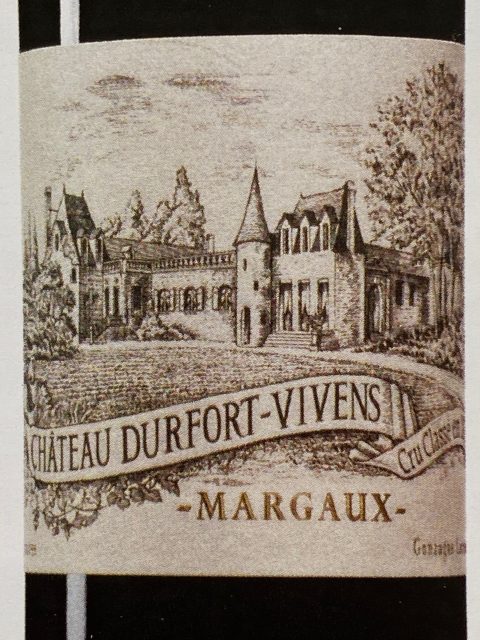
- Du Tertre (Margaux; 64% Cabernet Sauvignon; 10% Merlot; 20% Cabernet Franc; 6% Petit Verdot; 13% alcohol; a final yield of 37 hl/ha; tasted at the UGCB press tasting). Quite dark for du Tertre in both hue and concentration, especially in the context of the vintage. This is impressive, with a concentrated cassis fruit, blackcurrant leaf and a hint of redcurrant. Very classic and the product of 10 years’ hard work, this is another one of those top Margaux wines to express really well in this vintage the distinct fruit and floral profile that comes from its terroir. Very pure, very precise and with really good tight density in the compact mid-palate and that lovely fresh, bright, energetic fruit. The combination of Petit Verdot and Cabernet Franc brings natural complexity and interest especially in the mid-palate. No harshness and with lovely integration of the wood. This sings and, in so doing, shows lovely harmony. 91-93+.

